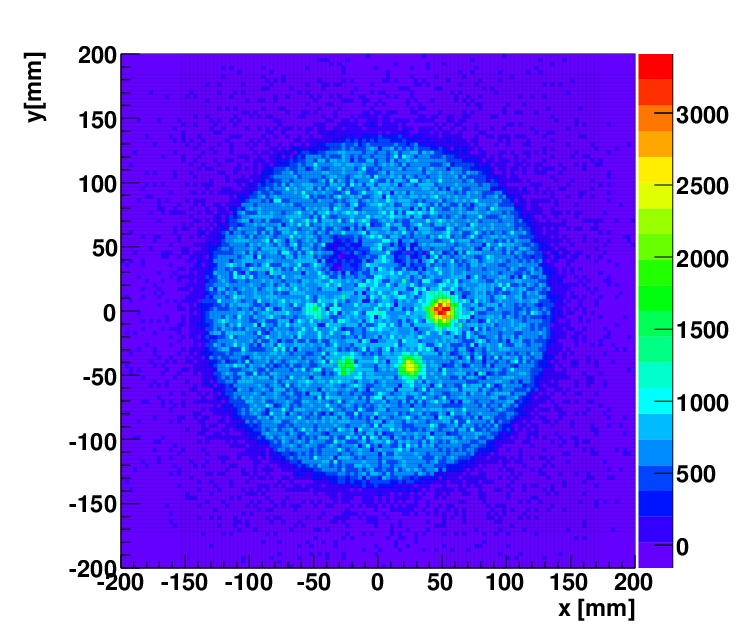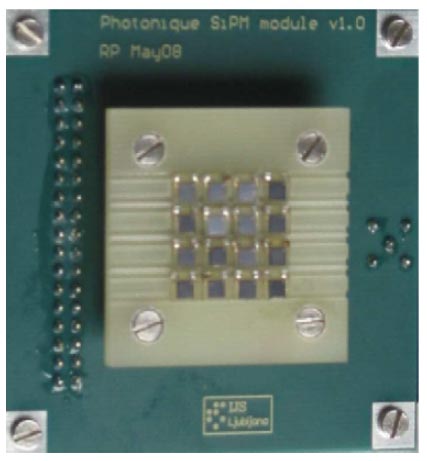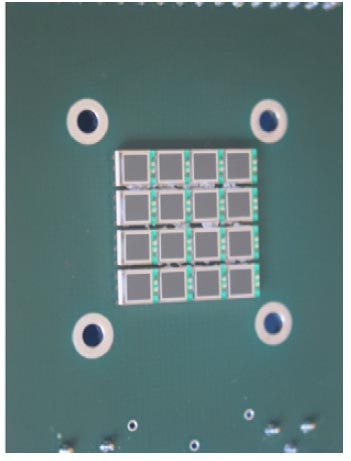The time resolution in
TOF-PET measurements is mainly limited by the time response
of the photodetector and the time constants characteristic
for the production of scintillation light. The limitation
due to the scintillation process can be avoided by using
Cherenkov light instead. This is produced promptly by a
passage of fast charged particle (e.g. an electron,
resulting from annihilation gamma interactions with matter)
trough a suitable material. Lead fluoride (PbF2)
was identified as the best available Cherenkov radiator
material. It has better gamma stopping power than the
scintillation crystals mostly used in PET, has excellent
optical transmission down to 250 nm, and is also
scintillation free.
First experiments were performed using monolithic PbF2
crystals coupled to very fast photodetectors, the
microchannel plate photomultipliers (MCP PMTs). In a simple
back-to-back detector arrangement, an excellent TOF
resolution of 87 ps FWHM was achieved using 15 mm thick PbF2
crystals.
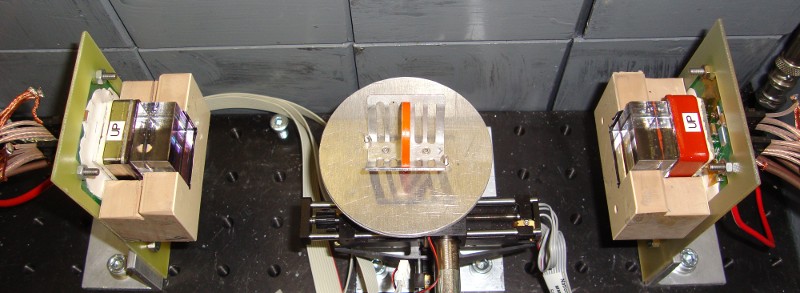
The experimental setup using MCP PMTs and
25x25x15 mm3 PbF2 crystals.
Visible in the middle is the 22Na
annihilation gamma source.
|
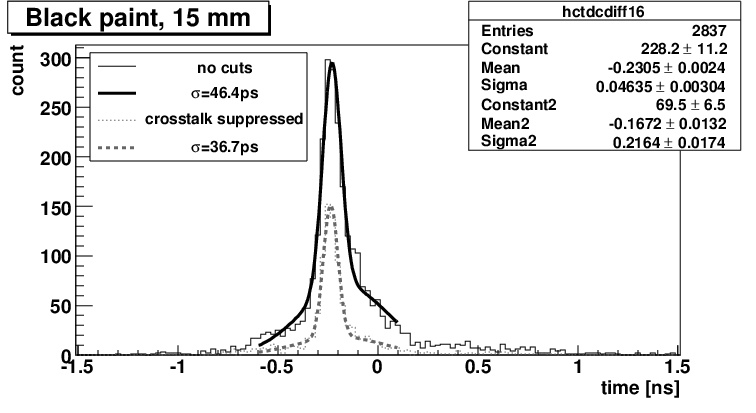
The coincidence time distribution obtained
using MCP PMT photodetectors. A time resolution of
87 ps FWHM was measured with 15 mm thick PbF2
crystals.
|
However, the detectors used had a
relatively low detection efficiency, mainly due to
the limited photon detection efficiency (PDE) of the
MCP PMTs used. The detection efficiency was
significantly improved when silicon photomultipliers
(SiPMs) were used as the photodetector. Using 3x3 mm2
active area SiPMs coupled to 5x5x15 mm3
PbF2 crystals, a single side efficiency
of 14% was measured with bare crystals and at high
SiPM overvoltage. Extrapolated to 1:1 SiPM-crystal
surface coupling, this infers that a 40% single side
efficiency is possible.
The SiPM have other beneficial properties, such as
relatively low cost and immunity to high magnetic
fields, but they have a slightly limited time
response and high dark count rate. With the SiPM
samples tested, a TOF resolution of about 200 ps
FWHM was measured in the best case. It has also been
demonstrated, that SiPM dark counts can be
significantly reduced by cooling.
Overall, using exclusively the Cherenkov light,
TOF-PET time resolution below 100 ps FWHM can be
achieved. Using photodetectors with sufficiently
high PDE, detection efficiency that is on the same
level as that of traditional, scintillation TOF-PET
can be reached. Additionally, a Cherenkov based PET
scanner could be produced at a lower cost since PbF2
is significantly less expensive than scintillation
materials currently used in PET.
|
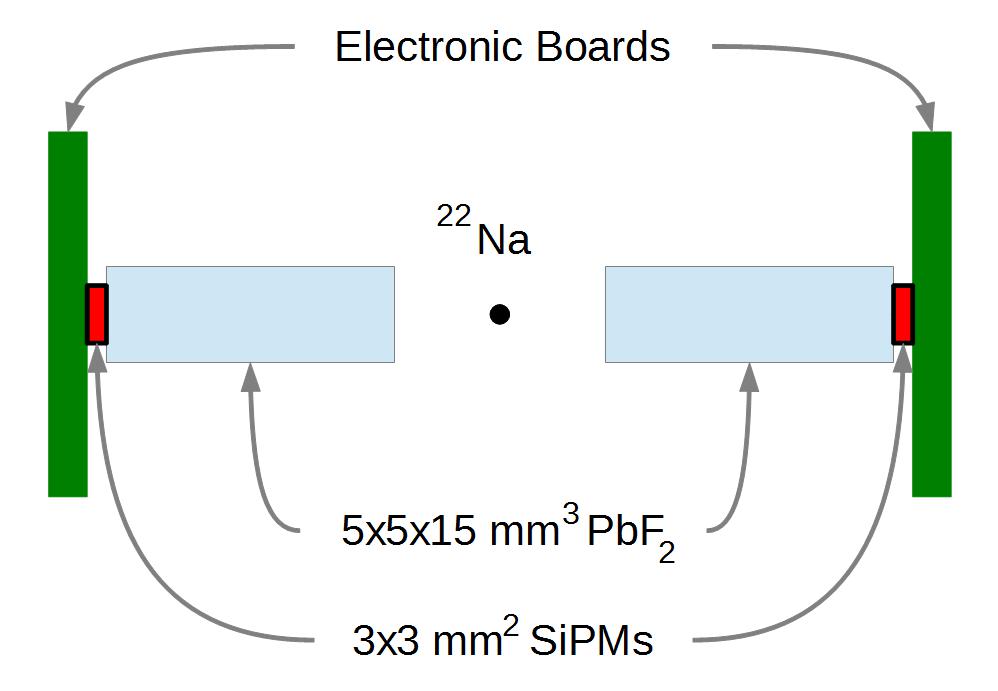
A diagram of the experimental setup used for
measurements with SiPM photodetectors.
|
Publications:
-
R. Dolenec et.al.,
Time-of-flight measurements with Cherenkov photons produced by 511 keV photons in lead crystals,
Nuclear Science Symposium Conference Record (NSS/MIC), 2010 IEEE, p. 280.
(doi)
-
S. Korpar et al.,
Study of TOF PET using Cherenkov light,
Nucl. Instr. and Meth. A 654 (2011) p. 532.
(doi)
- S. Korpar et al., Study of TOF PET using Cherenkov
light, Physics Procedia, 37 (2012) p.
1531. (doi)
- S. Korpar et al., Study of a Cherenkov TOF-PET
module, Nucl. Instr. and Meth. A 732 (2013) p. 595. (doi)
- R. Dolenec et al., Cherenkov TOF PET with Silicon
Photomultipliers, Nucl. Instr. and Meth. A 804
(2015) p. 127. (doi)
-
R. Dolenec et al.,
The Performance of Silicon Photomultipliers in Cherenkov TOF PET,
IEEE Transactions on Nuclear Science 63(5) (2016) p 2478.
(doi)
-
R. Dolenec et al.,
Efficiency of a Cherenkov based PET module with an array of SiPMs,
Submitted to the proceedings of the RICH 2018 conference (2018).
|
